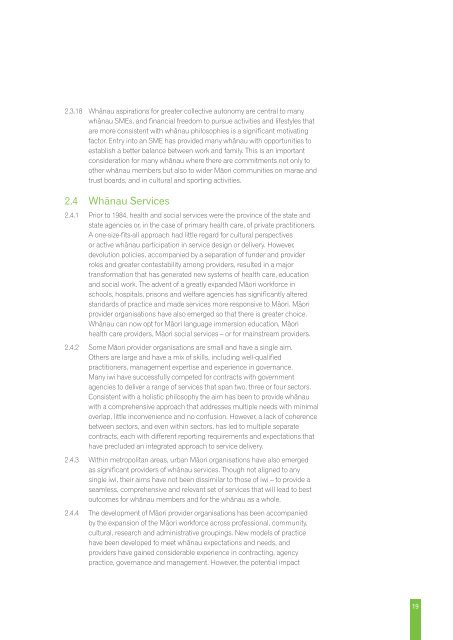Whanau Ora : Report of the Taskforce on Whanau-Centred Initiatives
Whanau Ora : Report of the Taskforce on Whanau-Centred Initiatives
Whanau Ora : Report of the Taskforce on Whanau-Centred Initiatives
You also want an ePaper? Increase the reach of your titles
YUMPU automatically turns print PDFs into web optimized ePapers that Google loves.
2.3.18 Whānau aspirati<strong>on</strong>s for greater collective aut<strong>on</strong>omy are central to many<br />
whānau SMEs, and financial freedom to pursue activities and lifestyles that<br />
are more c<strong>on</strong>sistent with whānau philosophies is a significant motivating<br />
factor. Entry into an SME has provided many whānau with opportunities to<br />
establish a better balance between work and family. This is an important<br />
c<strong>on</strong>siderati<strong>on</strong> for many whānau where <str<strong>on</strong>g>the</str<strong>on</strong>g>re are commitments not <strong>on</strong>ly to<br />
o<str<strong>on</strong>g>the</str<strong>on</strong>g>r whānau members but also to wider Māori communities <strong>on</strong> marae and<br />
trust boards, and in cultural and sporting activities.<br />
2.4 Whānau Services<br />
2.4.1 Prior to 1984, health and social services were <str<strong>on</strong>g>the</str<strong>on</strong>g> province <str<strong>on</strong>g>of</str<strong>on</strong>g> <str<strong>on</strong>g>the</str<strong>on</strong>g> state and<br />
state agencies or, in <str<strong>on</strong>g>the</str<strong>on</strong>g> case <str<strong>on</strong>g>of</str<strong>on</strong>g> primary health care, <str<strong>on</strong>g>of</str<strong>on</strong>g> private practiti<strong>on</strong>ers.<br />
A <strong>on</strong>e-size-fits-all approach had little regard for cultural perspectives<br />
or active whānau participati<strong>on</strong> in service design or delivery. However,<br />
devoluti<strong>on</strong> policies, accompanied by a separati<strong>on</strong> <str<strong>on</strong>g>of</str<strong>on</strong>g> funder and provider<br />
roles and greater c<strong>on</strong>testability am<strong>on</strong>g providers, resulted in a major<br />
transformati<strong>on</strong> that has generated new systems <str<strong>on</strong>g>of</str<strong>on</strong>g> health care, educati<strong>on</strong><br />
and social work. The advent <str<strong>on</strong>g>of</str<strong>on</strong>g> a greatly expanded Māori workforce in<br />
schools, hospitals, pris<strong>on</strong>s and welfare agencies has significantly altered<br />
standards <str<strong>on</strong>g>of</str<strong>on</strong>g> practice and made services more resp<strong>on</strong>sive to Māori. Māori<br />
provider organisati<strong>on</strong>s have also emerged so that <str<strong>on</strong>g>the</str<strong>on</strong>g>re is greater choice.<br />
Whānau can now opt for Māori language immersi<strong>on</strong> educati<strong>on</strong>, Māori<br />
health care providers, Māori social services – or for mainstream providers.<br />
2.4.2 Some Māori provider organisati<strong>on</strong>s are small and have a single aim.<br />
O<str<strong>on</strong>g>the</str<strong>on</strong>g>rs are large and have a mix <str<strong>on</strong>g>of</str<strong>on</strong>g> skills, including well-qualified<br />
practiti<strong>on</strong>ers, management expertise and experience in governance.<br />
Many iwi have successfully competed for c<strong>on</strong>tracts with government<br />
agencies to deliver a range <str<strong>on</strong>g>of</str<strong>on</strong>g> services that span two, three or four sectors.<br />
C<strong>on</strong>sistent with a holistic philosophy <str<strong>on</strong>g>the</str<strong>on</strong>g> aim has been to provide whānau<br />
with a comprehensive approach that addresses multiple needs with minimal<br />
overlap, little inc<strong>on</strong>venience and no c<strong>on</strong>fusi<strong>on</strong>. However, a lack <str<strong>on</strong>g>of</str<strong>on</strong>g> coherence<br />
between sectors, and even within sectors, has led to multiple separate<br />
c<strong>on</strong>tracts, each with different reporting requirements and expectati<strong>on</strong>s that<br />
have precluded an integrated approach to service delivery.<br />
2.4.3 Within metropolitan areas, urban Māori organisati<strong>on</strong>s have also emerged<br />
as significant providers <str<strong>on</strong>g>of</str<strong>on</strong>g> whānau services. Though not aligned to any<br />
single iwi, <str<strong>on</strong>g>the</str<strong>on</strong>g>ir aims have not been dissimilar to those <str<strong>on</strong>g>of</str<strong>on</strong>g> iwi – to provide a<br />
seamless, comprehensive and relevant set <str<strong>on</strong>g>of</str<strong>on</strong>g> services that will lead to best<br />
outcomes for whānau members and for <str<strong>on</strong>g>the</str<strong>on</strong>g> whānau as a whole.<br />
2.4.4 The development <str<strong>on</strong>g>of</str<strong>on</strong>g> Māori provider organisati<strong>on</strong>s has been accompanied<br />
by <str<strong>on</strong>g>the</str<strong>on</strong>g> expansi<strong>on</strong> <str<strong>on</strong>g>of</str<strong>on</strong>g> <str<strong>on</strong>g>the</str<strong>on</strong>g> Māori workforce across pr<str<strong>on</strong>g>of</str<strong>on</strong>g>essi<strong>on</strong>al, community,<br />
cultural, research and administrative groupings. New models <str<strong>on</strong>g>of</str<strong>on</strong>g> practice<br />
have been developed to meet whānau expectati<strong>on</strong>s and needs, and<br />
providers have gained c<strong>on</strong>siderable experience in c<strong>on</strong>tracting, agency<br />
practice, governance and management. However, <str<strong>on</strong>g>the</str<strong>on</strong>g> potential impact<br />
19

















